 |
|
|
|
| |
|
|
|
|
|
ANALOG
SYNTHESIZER PROGRAMMING
|
|
MIDI
COMMUNICATION
|
| |
|

| |
 |
||
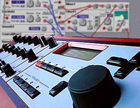 |
| NORD MODULAR EDITOR | |
|
The
Modular Editor environment is really exciting, expecially for those
who were so lucky to experience with analog modular systems in the
past. |
|
| THE EDITOR MENU BAR | |
| The picture on the left shows the top area of the Modular Editor screen (v.3), where system resources information, cables utilities and morphing controls are located. The PVA (Poly Voice Area) Display shows the processing power percentage used by the current patch, while the Voices Displays shows the requested (R) and actually available notes (C) for polyphony. In the lowest part of the bar different module groups are available and can be selected simply by clicking on the related group tab (I/O, Osc, LFO, Envelopes, Filters, Mixers, Audio, Control, Logic, Sequencers). | |
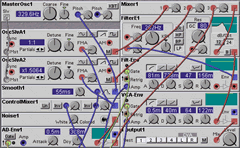 |
By
dragging the desired module icon to the lowest screen area, the module
will be forced to appear on the screen. In this way, several modules
can be selected in few moments. Once the modules are ready, virtual
cables can be used in order to connect the desired inputs and outputs. While connections are growing, the patch becomes more and more complex. Some utilities help the programmer in this case. For example, cables can be temporarely hidden in order to simplify the understandement of the patch or, again, cables can be shaked exactly like physical objects. The Modular offers a large number of modules for different programming applications. |
| POLY AND COMMON VOICE AREAS | |
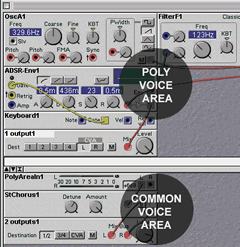 |
The
Editor v.3 introduced this new feature that allows to optimize DSP
power in order to face better and better the required polyphony. Two
main areas are available for programming divided by an horizontal
bar: - The Poly Voice Area, designed for patch modules that require polyphony; - The Common Voice Area, designed for modules that don't require polyphony. In this example a 6 voice patch is adressed to the CV area to be processed by a common stereo chorus module. Because the chorus is located in the CV area, his DSP load is not multiplied by 6, leaving more processing power available for additional programming. |
| MULTI-SYNTH PROGRAM FACILITIES | |
| Previous v.2 implemented the top bar with realtime information about the slot currently used (the Modular's 4 "memory slot" allows to manage up to 4 different sounds simultaneously). In addition to this, Editor v.3 allows to manage up to four Modular and/or Micro Modular synthesizers. It is possible to switch instantly to the desired synth and then enable the required slots A-D (Micro Modular architecture offers one slot only). Portamento and Bend Range controls are also available for instant editing of monophonic patches. | |
| PATCH BROWSER | |
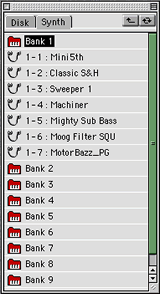 |
A special floating window is now available in order to check the Modular memory. In this way internal patches can be also easily selected when editing is needed. The Patch Browser v.3 allows to switch easily from the computer memory to the internal Flash RAM of the Modular, now optimized in order to supply more memory locations. Currently up to 9 banks (99 location each) are available depending from the size of the stored patches. |
| KNOB FLOATER | |
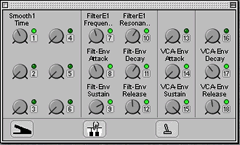 |
Any parameter of the patch can be easily assigned to the 18 knob located on the Modular front panel and an useful floating window is available in order to check the programmed assignements at any time. From v.3 the Editor Knob Floater (previously just a display) is interactive with the system. This means that moving a knob on the Modular panel will cause a movement of the related virtual knob on the Floater. More, the Floater's knobs can be also direcly moved with the mouse. |
| KEYBOARD FLOATER | |
 |
Another useful support if offered by the keyboard floater that allows to check the sound when using the Modular Rack or Micro Modular without a "physical" keyboard. |
|
|
|
|
|
|

